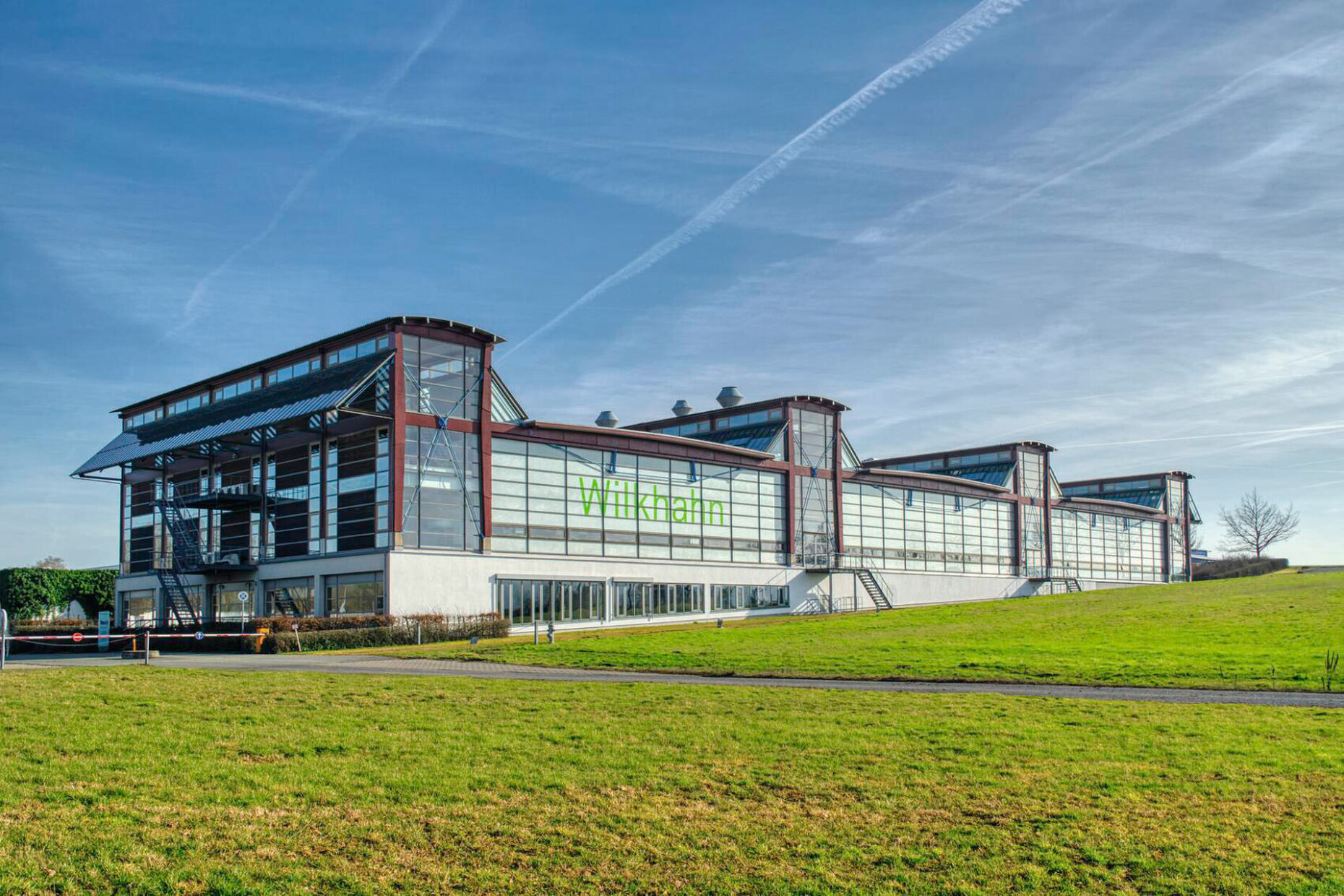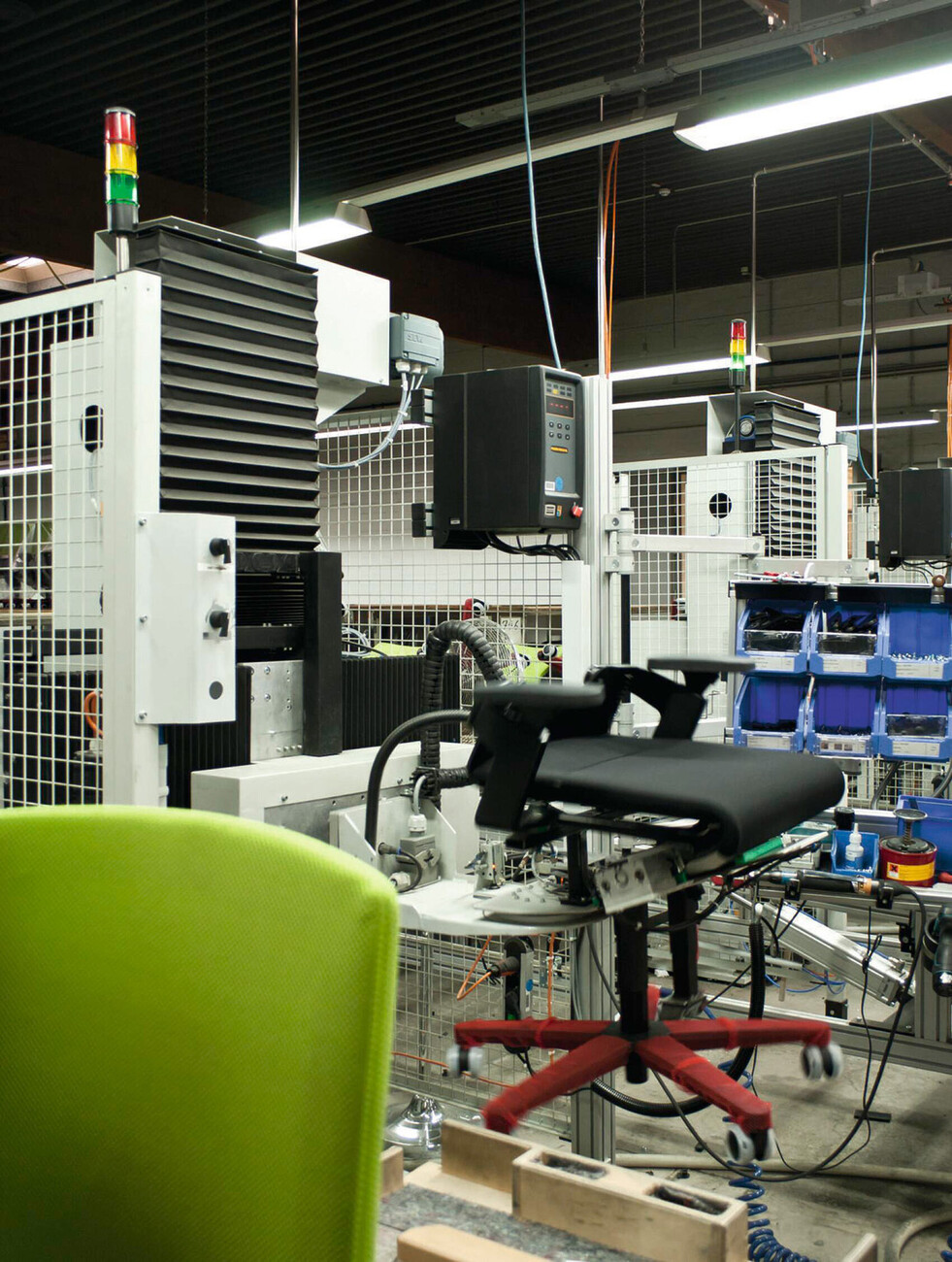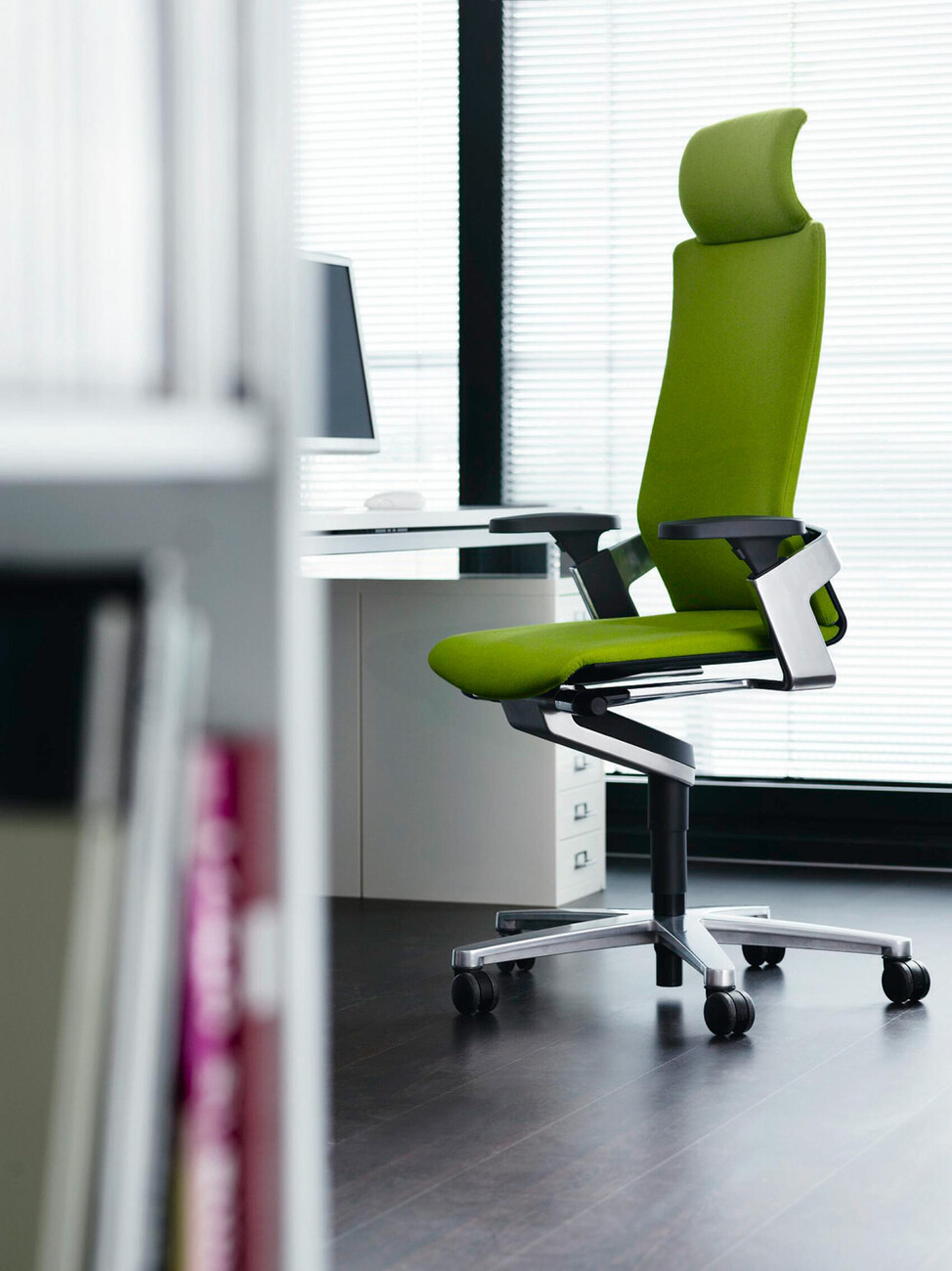Featured
Fair to People and the Environment
Anna Moldenhauer: Mr Hoffmann, what does Wilkhahn consider important when selecting materials?
Jörg Hoffmann: First of all, we make sure that all materials are ideally suited for their intended use. This way we ensure the high tactile quality and durability of our products. Another important aspect for us is that our products are low in emissions and contribute to good ambient air indoors. One of the specifications we set, for example, is that all our wood-based materials have a low formaldehyde content. We expect the same of our high-quality plastics some of which are made from recycled material; and the powder paints used in coating must be free of heavy metals. We also look at how the various materials are produced. This is why we audit our top suppliers to check they use energy efficiently and avoid production waste wherever possible. By choosing suitable materials in the design phase of our products we try to eliminate avoidable waste further down the line in terms of energy or offcuts.
Can you give us an example?
Jörg Hoffmann: For our “IN” swivel chair we opted for a knitted fabric instead of a sewn cover for the backrest and seat. This meant we could avoid the waste cuttings you would inevitably get when transferring the outline onto the rolls of fabric. A knitted fabric can be produced in many different shapes with only a few centimeters of start-up thread going into the machine and then perhaps a small piece of thread at the end. Compared to typical fabrics this offers great potential for avoiding waste. So you can say that defining the right materials and manufacturing processes gives us great scope for creating products that are both well-designed and efficient in their use of material. However, that is just one aspect. After all, we all know that a successful product has to meet many requirements and satisfy many customer preferences as regards the design and aesthetics, technical functions, and, of course, social and ecological aspects.
In other words, the details count?
Jörg Hoffmann: Precisely. For example, when we look at the various metal surfaces that Wilkhahn offers, then each one serves a purpose. All these surfaces or materials have specific properties. A polished surface is attractive and does not need any other materials to provide a coating. It gets sanded, brushed or polished and this makes it look decorative. That is a great advantage in ecological terms. With a powder-coated surface, little energy is required to apply the paint. At Wilkhahn we use powders that are free of heavy metals and melt at low temperatures. This way we can produce decorative colored surfaces that provide a different look from what you get with polished metals but are still ecologically sound.
From an ecological and work-safety perspective, chrome-plated surfaces are the ones that need to be viewed most critically. The chrome plating process is a galvanic finishing process comprising several stages in which hazardous substances are also used and which involves decorative metal coatings being applied to metal parts in an electro-plating tank. It is crucial that the electroplating process is operated safely in accordance with strict environmental and social requirements. Once again, we conduct regular audits with our suppliers; to that end, among other things we assess whether harm to employees is avoided and whether the electroplating tanks are operated as long as possible in order therefore to avoid unnecessary waste.
What demands does Wilkhahn make of partner firms?
Jörg Hoffmann: We are a design-oriented manufacturer and rely on specialized suppliers who operate according to social and ecological guidelines. A supplier can only become a partner company when we are fully convinced that it operates properly and ultimately in a manner that is safe both for its employees and the environment. We have a system in place whereby our top supplier companies are audited every three years on the following topics: employee relations, HSE, renewable energies, and so on. We pay regular visits to our suppliers rather than settling for self-declarations. It helps that we generally have lasting, long-standing relationships with our partners. As we see it our responsibility does not begin and end at our own factory gate.
Wilkhahn not only offers to refurbish its products but also to recycle them. How does that impact workflow?
Jörg Hoffmann: In recent years, corporate Germany has started to focus more on the circular economy and circularity. To my mind, this has a different quality than what we used to term the “recycling economy”, namely a system for dealing with waste. Back in the 1990s Wilkhahn began, at the very start of the design process, to wonder what happens to our products at the end of their service life. This is why they are designed in such a way that individual elements can be replaced at any time, such as the armrests or castors of a swivel chair – both of which wear out more quickly. There is also a further dimension to circularity which concerns the early selection of the materials. It is the design phase that ensures a product remains waste-free through all the technical cycles. Now that invariably also spells compromising here and there. Key basic principles at Wilkhahn are the durability of materials, a modular product structure, and wherever possible using mechanical connectors rather than adhesives. Most of our production, including our own upholstery work, is located in Germany. This means that even many years later we are able to renew elements especially subject to wear-and-tear, such as covers, at a reasonable cost. These are very important aspects with regard to circularity.
Can you give me some examples of Wilkhahn products that are especially sustainable?
Jörg Hoffmann: When it comes to swivel chairs, then the obvious choice is “ON”, which received the German Ecodesign award, the highest state prize for ecological design in Germany. Then there is our “IN” swivel chair. Both are made largely of recycled materials and are over 90 percent recyclable. Generally speaking, all our products are low-polluting. With the new “Yonda” shell chair we have deliberately broken new ground and moved away from conventional plastic to explore new avenues with a bio-composite made of 70 percent post-consumer recycled polypropylene and 30 percent wood fiber from waste wood. Moreover, Yonda is designed to guarantee circularity, as parts can be separated purely.
Wilkhahn started producing sustainable products early on. Developed in 1993, “Picto” for example was conceived at a time when plastic was still very much in favor, yet it could already be separated by type. What is the basis for this far-sighted philosophy?
Jörg Hoffmann: Sustainability has been Wilkhahn’s primary guiding principle since the 1980s. Back then the topic was firmly anchored in the Board of Directors’ mission statement, and the corporation resolved that in case of doubt we would place greater value on the ecological aspect of our actions than on making a quick profit. Our early commitment to holistic sustainability was rewarded among other things with the German Environmental Award of the German Federal Environmental Foundation. We prefer to think a little longer about what the added value of a product could be rather than conceiving some mass product which is then discarded before it is technologically obsolete, or its design is no longer thought fashionable. The very first furniture items Wilkhahn manufactured were robustly crafted wooden chairs – joinery items that already reflected the basic ideas of the Bauhaus: Avoid waste and use resources effectively by opting for an aesthetics of pure form. In our view the world has a surfeit of bad products that lead to an inacceptable waste of resources and littering. Everything that is designed should primarily be useful and then also be able to be used again if possible.
And one aspect is that you don’t follow trends such as a color that enjoys brief popularity.
Jörg Hoffmann: Precisely. Needless to say, it’s a balancing act. Why do we survive as a company? The reason is that we please our customers with our products. That means we shouldn’t pretend to have an answer to everything. Instead, with our products we show how we attach high priority to good design, the efficient use of materials, and other social and ecological aspects. Simultaneously, by relying on the principle of modularity we can let customers choose their own individual design. With the help of interchangeable color shells, we can also take trends into account without the product itself becoming arbitrary.
Over the years Wilkhahn has received a large number of certifications such as the ISO 9001 for the headquarters with the production plant and the European sales offices, not to mention the Blue Angel quality seal for the “AT” swivel chair – why are they so important for the company?
Jörg Hoffmann: When we have the time and the opportunity to talk to clients directly, we always want to be able to prove that what we do can be relied on and that it is based on prioritizing fairness – towards people but also to the environment. Nonetheless, certificates also have their usefulness, namely in situations where I’m unable to reach customers directly. In addition, there are big differences between the markets and who decides what is safe. For example, in the UK, United States and Australia there is a certain tradition of making product safety the responsibility of the market. Certificates allow consumers to evaluate products in a manner that is perceived to be transparent. By contrast, in core Europe there is a strong tradition of regulatory law whereby safe and environmentally-friendly products are created primarily through the regulation of input factor and manufacturing methods.
What energy does Wilkhahn use for its manufacturing plant?
Jörg Hoffmann: It has long been a matter of course for Wilkhahn to strive to use green energy as much as possible. The type of green energy you opt for depends on local conditions and say how many hours of sunshine you have. Back in the early 1990s, we already realized a factory extension based on ecological criteria and installed one of the first photovoltaic systems in northern Germany. Although photovoltaic plants now provides a good alternative it has taken years for it to become really efficient. As our headquarters are located in a rural area this also means we have access to natural raw materials. This is why we were able to operate a combined heat and power plant as early as 2007 and generate energy and heat from carbon-neutral vegetable oils like rapeseed oil.
Today, we have taken things a few steps further and since 2012 have relied on heat from biogas with the raw material coming from the local farming areas. Last year we were able to source three-quarters of the heat we need from this green energy. We only have to fall back on another form of energy during the cold peaks in the year when the biomass district heating is not yet sufficient. And we are currently exploring how we can supply the remaining amount with other types of green energies – be it gas or hydrogen. The technical possibilities are changing as are production requirements. Today, for example, we use considerably less electricity than we did 20 years ago. In other words, the surplus electricity from our solar PV system could be put to other uses in future.
In addition to obtaining 77 percent of heat from a biogas-driven district heating system, in 2022 Wilkhahn has also succeeded in cutting its electricity consumption by 19 percent compared to 2019. What measures were necessary to achieve this?
Jörg Hoffmann: For one thing, ten years ago LED technology was not readily available for industrial use. Today, however, it is highly reliable as regards brightness and duration so that switching to this technology to light offices, halls, and showrooms has translated into a decisive reduction in our electricity requirement. Moreover, considerable progress has been made with regard to machine efficiency. Today, an air compressor is 30 percent more efficient than 20 years ago. We analyze how the technical infrastructure is changing and what would be a good time to replace machines with a high level of consumption. We currently operate with 100-percent green electricity. Our goal is to make Wilkhahn headquarters at least 80-percent climate-neutral by 2025.
With regard to transport Wilkhahn focuses on minimizing air freight, optimizing routes, and making efficient use of cargo loads. Speed also counts for an internationally oriented company – how do you ensure that the goods can always be delivered on time?
Jörg Hoffmann: By planning the delivery routes precisely, meaning down to the last detail. We have also identified which regional service providers will handle after-sales service. This means they can reach the customer quickly yet avoid long journeys and save resources. All internal workflows are subject to the PDCA approach: Plan, Do, Check, Act. We assess the requirements, plan accordingly in order to meet them, put them into them, and then regularly check whether and how we need to calibrate them in order to meet the premium standards we set ourselves for our customers in the long term. We live and breathe this process in the context of our management system. A current challenge when it comes to avoiding emissions is the organization of supply chains as this often involves an international division of labor. Smart logistics is one of the most important factors for us, both financially and as regards emissions in order to make fairness towards people and the environment credible beyond our own factory gates.
The timelines for Wilkhahn products are also very long.
What sustainable goals and research projects does Wilkhahn currently have?
Jörg Hoffmann: For logistics we would like to be able to collect more detailed CO2 data in the next few years because we definitely want to be able to offer even greater transparency. Environmentally-friendly materials are another topic going forward: We are interested in ideas that go beyond our current range of recycled wool or recycled PET. Years ago we already tried out the 3D-printing process with a synthetic made from the wood component lignin. That was an exciting innovation as regards both material and process. Together with our head of design management, Michael Englisch, we have also been collaborating with research institutions to determine to what extent structure-forming mycelia, or fungi might be interesting for furniture-making, for example as a substitute for the foams so commonly used today.
However, many of these far-sighted research projects are not yet ready for industrial timescales because they are too slow, for one thing. We are also acting as an applied partner in another project researching into innovative lightweight wood-based materials that are practically free of petroleum-based adhesives and are emission-free. Many of the new types of particularly ecological materials still involve variables that we cannot always expect our customers to accept. Conventional plastics can be produced quickly, are lightfast, scratch-resistant, and pleasant to the touch and show only slight variations in quality. If these are replaced, say by recycled materials variations in color and structure can increase significantly. The exciting question will be to what extent our customers who are accustomed to perfection will join us on this journey. To what extent can we create acceptance for the fact that products recycled in an especially sustainable manner from recycled wool and recycled plastic, for example, sometimes have different color nuances or have unique fiber patterns? From my perspective an intriguing question will be: to what extent does the market not only want the sustainable story, but is also prepared to go along with the visual and haptic changes associated with recycled material?
My hope is that these natural deviations from a norm will be considered a mark of quality for a sustainable product.
Jörg Hoffmann: This issue remains a tantalizing balancing act as luckily for us customer requirements vary. It is our task to find a new approach to sustainability. The future is not yet set in stone and we at Wilkhahn together with our customers would like to play our part in shaping it.
























